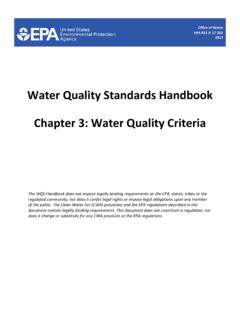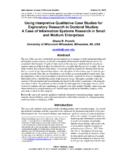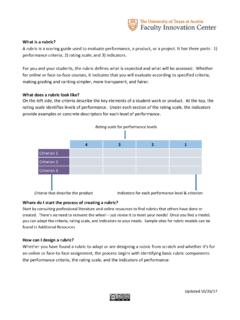Transcription of Students’ Perceptions towards the Quality of Online ...
1 861 Students Perceptions towards the Quality of Online Education: A Qualitative Approach Yi Yang Linda F. Cornelius Mississippi State University Abstract How to ensure the Quality of Online learning in institutions of higher education has been a growing concern during the past several years. While several studies have focused on the Perceptions of faculty and administrators, there has been a paucity of research conducted on students Perceptions toward the Quality of Online education. This study utilized qualitative methods to investigate the Perceptions of students from two universities and one community college regarding the Quality of Online education based on their own Online learning experiences. Interviews and observations were conducted with three students. Various documents were collected, digital and printed.
2 Positive and negative experiences of students were examined. Factors that contribute to those experiences were also identified. The findings of this research revealed that flexibility, cost-effectiveness, electronic research availability, ease of connection to the Internet, and well-designed class interface were students positive experiences. The students negative experiences were caused by delayed feedback from instructors, unavailable technical support from instructors, lack of self-regulation and self-motivation, the sense of isolation, monotonous instructional methods, and poorly-designed course content The findings can be used by instructors to understand students Perceptions regarding Online learning, and ultimately improve their Online instructional practices. Introduction With the fast development of the Internet, many colleges and universities have offered Online courses as a viable alternative to traditional face-to-face instruction.
3 However, considerable concerns and problems have developed, particularly as it relates to the Quality of Online education. Online education, according to Harasim (1989), is a new domain of learning that combines distance education with the practice of face-to-face instruction utilizing computer-mediated communication. Ascough (2002) suggested that Online education has the following features: (a) it provides a learning experience different than in the traditional classroom because learners are different, (b) the communication is via computer and World Wide Web, (c) participation in classroom by learners are different, (d) the social dynamic of the learning environment is changed, and (e) discrimination and prejudice is minimized ( ). New technologies, the Internet, streaming video, net-meeting etc.
4 Now makes higher education more accessible and affordable for many students, and for those who would have been unable to pursue higher education in a traditional in-class setting (Bianco & Carr-Chellman, 2002). Consequently, Online learning has now become an integral part of higher education institutions expanding curriculum. The term Online education is often associated with Internet education, virtual education, cyber-learning, and asynchronous learning (Office of Sustainable Development, 2000). Kearsly (2000) reported the following themes that shape Online education: collaboration, connectivity, student-centeredness, unboundedness, community, exploration, shared knowledge, multisensory experience, and authenticity (p. 4-10). Volery (2000) also concluded that Online delivery is a form of distributed learning enabled by the Internet.
5 According to Paulsen (2002), Online education is characterized by: the separation of teachers and learners (which distinguishes it from face-to-face education), the influence of an educational organization (which distinguishes it from self-study and private tutoring), the use of a computer network to present or distribute some educational content the provision of two-way communication via a computer network so that students may benefit from communication with each other, teachers, and staff. ( ) Online courses and degrees have been widely adopted by higher education institutions as another method to substitute traditional classroom instruction. Allen and Seaman s (2003) recent survey on Online education delivered by higher education institutions in the United States, found that at least 80% of the course content delivered by those institutions were delivered Online .
6 Regardless of the definition, an early indication of the widespread popularity of 862 Online education courses can be found in a survey conducted by the Department of Education, which revealed that more than 54,000 Online education courses were being offered in 1998, with over million student s enrolled (cited in Lewis, et al., 1999). In a more recent study, Allen and Seaman (2003) reported that: (a) over million students took at least one Online course during the Fall of 2002, (b) over one-third of these students (578,000) took all of their courses Online , (c) among all higher education students in Fall 2002, 11 percent took at least one Online course, and (d) among those students at institutions where Online courses were offered, 13 percent took at least one Online course ( ).
7 Statement of the problem Although it is has been reported in a recent study that 80% of course content offered in institutions of higher learning are being delivered Online (Allen & Seaman, 2003), students in this study were still reluctant to take Online courses and complained about the Online classes they had taken. One participant noted, Not only does the courses costs more, but they made me feel lost all the time (Personal communication, November 11, 2003). Another participant stated, The Online class was very boring, and I don t feel the instructor helped me a lot (Personal communication, November 11, 2003). It appeared that these students held unpleasant experiences from their prior Online learning experiences. What caused their negative experiences? Was it the learner themselves?
8 Was it the program? Or was it because of the instructor? How do students perceive the Quality of Online education based upon their own Online learning experiences? Are they satisfied or dissatisfied with the Online education they have received? What are the factors that shape students Online learning experiences? All of those questions prompted the present study and its investigation to explore students Perceptions towards the Quality of Online education. Rationale for study As the number of Online education courses in higher education has increased, concerns and issues have arisen about the Quality of these courses (Yang & Cornelious, 2003). Many problems that have arisen in Online education regarding its Quality are often related, but not limited to: (a) the requirement of separate Quality assurance standards, (b), programs having low (or no) Quality standards, and (c) there is no consensus on what constitutes learning Quality (Twigg, 2001).
9 Carnevale (2000) reported that Nick Smith (D, Michigan), the chairman of the House of Representatives science subcommittee on basic research expressed deep concerns about the Quality of internet-based courses during a hearing in May of year 2000. Representative Smith stated that he remained skeptical of the Quality of Online learning, .. students who take courses Online don't interact as much as their peers in traditional courses, and that they may walk away with knowledge but not with an understanding of how to think for themselves (p. 51.) Concerns have also arisen as to the use of technology as a panacea to correct financial problems of institutions rather than serve as a valid teaching method (Hensrud, 2001). Brown & Green (2003) have also argued that Online course delivery is often viewed by administrators as a cash cow venue a means of delivering instruction to a large number of paying customers without the expense of providing things such as temperature controlled classroom and parking spaces (p.)
10 148). Many opponents of Online education question whether or not Online learning can provide the same interaction between instructor-students and students-students as traditional classrooms offered (Roblyer & Ekhaml, 2000). Some opponents also question the Quality of Online education since the Quality of instructors who teach Online courses cannot be guaranteed (Weiger, 1998). Arguments are made that as consumers of Online education, students are unlikely to be able to find out information about the Quality of the courses that are provided (Twigg, 2001). Schools or universities that offer Online education courses typically do not provide comparative information for students , how would a student know which Online course meets his/her needs? Moreover, prerequisites that are essential for taking a particular Online course are usually not clearly stated on websites for students, and when students are encountering technical problems, who will they be able to ask for assistance if it is not available to them (Twigg, 2001, p.















